
FRANZ GEORG REHAGEN FAMILY
By William J. Weidinger
The following articles appeared in the Miller County newspaper The Advertiser about mid 2015:
Article #1 - Introduction
Having written some nine articles about the Bax family tree previously, I am now going to attempt to do a similar thing for the Rehagen tree. My mother’s maiden name was Rehagen and therefore I am more familiar with this tree at the onset of writing this document than I was with the Bax tree. That won’t necessarily make my writing any better, but it will definitely make it easier.
I will again use the same sequence as last time. I will begin with the newspaper articles, ask for additional pictures and corrections from the public at the end of those and in the end put the final document with all the pictures I can come up with on the Miller County Museum site. Use http://www.millercountymuseum.org/people/bio_b.html to navigate to the list of biographies for surnames that begin with the letter B if you wish to revisit the Bax articles or you can even use the download link for the 22 page PDF file that is located at the end of the biography.
Let’s begin back in the Germanic region of Westfalen in the mid nineteenth century. Things were not going well for the citizens of the region – war, economic struggles, religious conflicts and so on led to a huge Germanic immigration to this country. Among those immigrants were five Rehagen siblings. Their parents were Franz Georg Rehagen (1778-1848) and Anna Maria Kilian (1777-1847). They lived near the town of Sudhagen and had ten children. Just to the northeast is the town of Delbrueck. Located there is Saint John the Baptist Catholic Church in which the couple was married and all of their children were baptized.
In the coming weeks I will detail the five branches of the family tree with the major focus being Johann Jodocus Rehagen’s branch since he was the only one of the five to move to Miller County along with some of his children. I will most likely take a side trip on at least one occasion to focus on a branch that has died out, but has a lot of history and points of interest within it.
Living members of the Rehagen family tree are part of the intended audience rather than part of the subject matter. Therefore, I will attempt to follow the branches far enough for readers to identify their ancestors. Much of the information comes from Ancestry.com and I would consider it to be very good, however, not perfect. Sometimes conflicting dates and names appear and there is no way to determine the real story.
Article #2 - Anna Maria Catherine Rehagen (1813 -1885)
In this the second article about the Rehagen clan, I will be detailing the records of the only girl of the five siblings to come to this county. I believe her to be the first to leave the town of Sudhagen and move to Osage County – the first stop for the majority of German immigrants in the central Missouri area.
Anna Maria Catherine Rehagen (1813-1885) married Hermann Schroeder (1813-1891) on 5 May 1840 back in Delbrueck. But, what about her name? Anna Maria Catherine – now that’s a mouth full. The German tradition was to give a saint’s tribute to the child’s first name and then use the second or third name as their common name. So she became known as Maria. In fact she had five sisters and every one of them were given Anna as their first name.
The birth of Hermann and Maria’s first three children occurred back in Germany, however their fourth child was born in route to this country in December of 1846. Her four brothers immigrated a few years later in the 1850’s. I’m sure letters written to her family back in Sudhagen helped motivate them to come to America. Kudos to Maria and Hermann for being those first brave souls to leave their place of birth and upbringing and come to central Missouri to start a new life.
Listed below are the six children of Maria and Hermann and their spouses.
Mary Anna (? – 1921) and William Beckman (1819 – 1897)
Mary (? – 1916) and Herman Gassel (1835 –1889)
Frank (1845 – 1916)
Bernard (1846 – 1934) and Anna Luebbert (1847 – 1936)
John (1849 –1927) and Gertrude Schleuter (1852 – 1902)
Anna M (1850 – 1931) and John M. Struemph (1847 – 1924)
Maria and Hermann remained rooted in Osage County. Both died and are buried there – Maria in Westphalia and Hermann in Rich Fountain. In addition, the four youngest children also remained rooted in Osage County.
Finally, the 1880 Federal Census listed Hermann and Maria Schroeder just above John Rehagen - born Johann Jodocus Rehagen. This would indicate that they were neighbors on what was most likely adjoining farms. Johann was Maria’s younger brother and will be of major interest in later articles.
Article #3 – Georg Stephan Rehagen (1807 – 1878)
Georg Stephan Rehagen (1807 - 1878) married Anna Maria Angela Wilmers (? – 1898) in 1835 back in Germany. Records are in disagreement on his name as he appears as Franz Stephan in some instances. In any case Stephan was the oldest of the Rehagen siblings to come to this country. He along with his wife and five children made the trek to New Orleans in 1851. At the age of 44 and with so much linkage to his extended family and place of birth, that must have been a very difficult decision.
The 1860 Census shows that Stephan and Anna Maria were farming in Osage County and that two more children had been born since their arrival to this country. Owning land was perhaps the biggest draw to this country. Back in Germany, land was passed down to the oldest son of the family. This made it very difficult for the other children to ever own land. Their livelihood depended on employment by landowners, thus making them for all practical purposes economically enslaved to them. Some could escape that situation by entering into a trade such as carpentry or wagon making. So often a ship’s manifest would show farming as the passenger’s trade. What it really meant was that they were farm hands rather than farm owners.
Even though Stephan and Anna Maria were older than most immigrants, it all worked out. They acquired land, had children, saw their children grow into adults in a country were opportunity was so much more abundant than Germany.
Listed below are the seven children of Stephan and Anna Maria along with their spouses.
Anna Angela Maria (1838 – 1863) and Simon Groner (1830 – 1903)
Frank William (1840 – 1933) and Katharina Abkemeyer (1846 – 1919)
Wilhelmina Catherina (1842 – 1941) and Herman Sonnen (1824 -1878)
Gustav Daube (1849 – 1919)
George Wuehling (1844 - ?)
Joseph B. (1845 – 1920)
Martin (1849 – 1892) and Elizabeth Luebbert( ? - ?)
William (1851 – 1930) and Anna Liermann (1849 – 1936)
Anna (1856 - ?)
You might look at the third child in this list one more time. Wilhelmina was born in Germany, moved to this country as a child, lived to be almost 100 years of age and was married three times. Wow! Below is a picture of this very interesting lady (Photo 01):
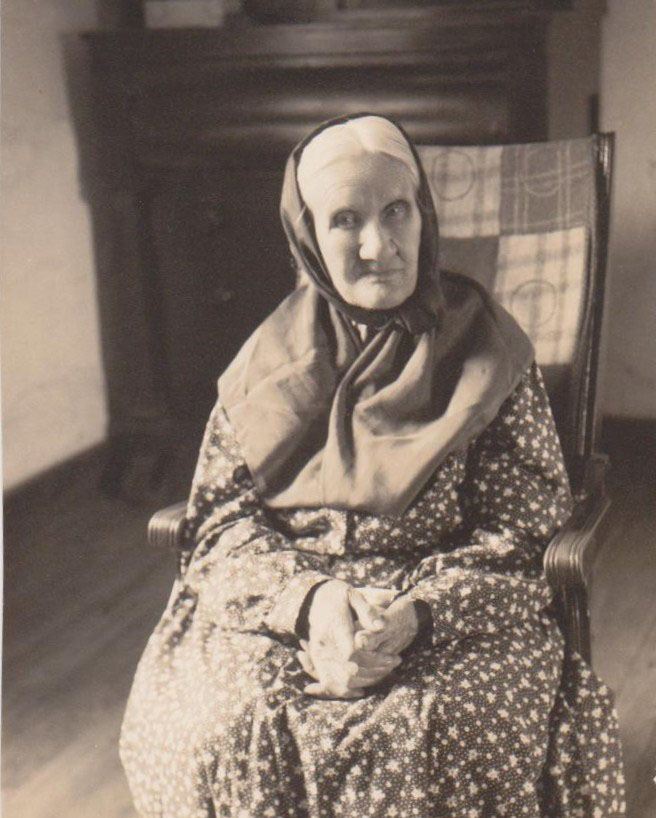
Wilhelmina Catherina (1842 – 1941)
Like his sister and brother-in-law, Stephan and Anna Maria remained rooted in Osage County. Their children for the most part remained in Osage County as well.
Article #4 - Conrad Rehagen (1824 - 1910)
Conrad Rehagen began his trek to New Orleans from Bremen in 1850 on the sailing ship Tarquin and set foot on American soil on 26 Dec 1850. Aboard that same ship was an older brother Martin and his family. What a wonderful Christmas season that must have been for them.
Conrad remained in New Orleans for some 15 months perhaps to earn money to start up his new life here in America. Eventually he made his way to Missouri like his brother Stephan and sister Maria before him. However, instead of settling into Westphalia immediately he married his first wife Frances Rupp (1820 - 1856) on 23 Nov 1852 and resided in Taos. This would have been a bit unusual as Fr. Helias attempted to separate the Germanic immigrants by their region of origin. Those from Westfalen, like Conrad, settled into Westphalia, Bavarians to Rich Fountain, Rhinelanders to Loose Creek and assorted others to Taos. Fr. Helias was wise to separate these groups since they differed in language, customs and were often at war back in their birthplace.
Frances gave birth to their first child John on 16 Nov 1853. Unfortunately John died the following year. On 23 Feb 1856 Frances and their second child Louise passed. Sadly women and their babies died all too frequently in those days.
Conrad remarried a widowed lady, Augusta “Theresia” Falter (1833 – 1911), on 25 Nov 1856 in Westphalia. Once again tragedy struck. Their first child, Francis, was born 29 Aug 1857 and died some two weeks later. It was time for life to bring forth some good fortune and it did. Conrad and Theresia eventually brought nine children into their Westphalia home.
The family which included two children from Theresia’s first marriage made their home in the town of Westphaila until they moved to a farm previously owned by Wilhelm Oligschlaeger in about 1875. Conrad made wagons and cabinets during their town dwelling and continued some of his crafts after they moved to the farm. The farm was eventually taken over by their son Frank and would later rank as a century farm.
Below is a picture of Conrad (Photo 02):
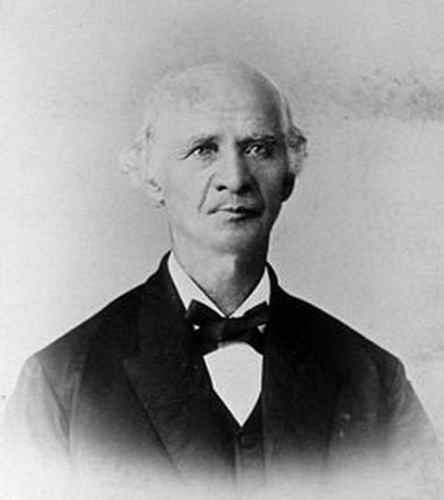
Conrad Rehagen (1824 – 1910)
Listed below are the nine surviving children and their spouses:
Marie Elizabeth (1859 - 1898) and John Bernard Koetting (1850 – 1916)
Anna Antoinette (1861 - 1945) and Johannes Stephan Oligschlager (1853 - 1929)
John Joseph (1863 - 1951) and Kate Sting (1866 - 1954)
Clara (1865 - 1951) and Christopher Schneider (1863 - 1915)
Maria Theresia (1867 - 1954) and Alexander Young (1866 - 1918)
Wilhelmina (1869 - 1948) and Leonard Heinrich Bernard Bode (1862 - 1931)
Frank (1871 - 1965) and Elizabeth Amalia Bode (1869 - 1945)
Catherine (1874 - 1901) and Henry B Lauf (1854 - 1930)
Frederick Anton (1877 - 1947) and Laura Victoria Von Arx (1879 - 1968)
Article #5 - Johann Martin Rehagen (1821 - 1895)
You may recall from the previous article that Martin and his young family arrived in New Orleans aboard the sailing ship Tarquin on 26 Dec 1850.
Unlike his siblings, Martin did not settle in central Missouri. He chose rather to stay in New Orleans instead. I am not sure if his chosen career as a tailor was developed back in Germany or in New Orleans. My guess would be that this happened in New Orleans. He most likely worked as a farm hand like his brothers before coming to this country. Along with a new profession he also chose a new name - Rehage. I would assume that when the "n" was dropped from Rehagen it became less conspicuous in the predominantly French population of New Orleans. That may have very well helped his sales in the tailoring business. I might mention here that the Rehagen name had several spellings on church records back in Delbruck. It could well be as simple as errors made by the church officials when documenting the records. Rehage was one of the spellings used for those church records.
I did not find marriage records for Martin and his wife Catherine Schlueter (1821 - 1905). It would appear that they married before immigrating to America as their first child was born in early 1849 and their second was believed to have been born on board the ship during their voyage in late 1850.
Below is a picture of Martin (Photo 03):
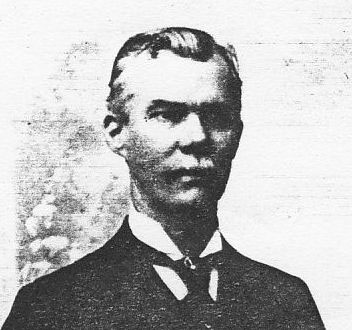
Johann Martin Rehagen (1821 – 1895)
Listed below are the six children of Martin and Catherine Rehage:
John Anthony (1849 - 1926) and Marie Hardes (1859 - 1883)
Madeleine Sturmer (1863 - 1939)
Adolph John (1850 - 1929) and Elise Oldis (1854 - 1940)
Marie (1853-1936) and Conrad Weinberger (1845 - 1889)
Martin (1855 - ??)
Anna Regina (1860 - 1930) and John N Frown (1860 - 1935)
Peter Rudolph (1863 - 1926) and Marie Dulhome (1867 - 1913)
A little footnote may be in order here. If you do an Internet search for Rehage in New Orleans, you will find that the name lives on in that city and that the name is associated with music and entertainment. There seems to be an occasional music gene that pops up in the Rehagen line. My mother, her father and grandfather all had it. I'll elaborate on that more in later articles.
Article #6 – My great grandfather Johann Jodocus Rehagen (1818 – 1903)
Known as John in this country, he was most likely known as Jodocus back in the town of Delbruck. For those who are new to dealing with family history, keep in mind that names and dates are moving targets. This man’s given name took on different forms depending on location and circumstance. I have seen at least five different spellings of his surname. The historical records we see today are only as good as the accuracy of the individual writing the document way back when. It’s just one of those things you have deal with when doing ancestral research. You simply have to tiptoe through the minefields of success as best as you can.
On 25 Sep 1841 he married Anna Maria Catharina Brinkmeier (1810 – 1842). On 18 Sep 1842 their first and only child was born. She was Anna Maria Elizabeth. Sadly her mother died that very same year. The exact date of her death is not known and therefore it is not known if her death was due to complication with the birth. That would be the most likely cause of course. The baby, later known as Mary, survived the ordeal and lived a long and full life. More about her later.
John’s second marriage was to Anna Angela Winkel (1826 – 1896) on 20 Apr 1847 again in the town of Delbruck, Westfalen. They had two children, Angela Maria and Francis Henry, before making their trek to this country. The young family departed Bremen on 25 Nov 1851 aboard the “Itzstein and Welker” and arrived at New Orleans on 28 Jan 1852. Later that year they made their way to Westphalia, MO. One member of the family did not survive, however. Their little girl Angela Maria passed away that same year. It is unclear as to where and when she died. Some accounts say she died onboard the ship. The ship’s manifest does not support that, however.
On 25 Mar 1852 their third child, Conrad, was born. Over the next fifteen years they had six more children. Anna Maria was born in 1854. Angeline was born in 1856. Herman Stephen was born 16 Jul 1858. Theresa was born 8 Nov 1860. Wilhelmina was born 29 Apr 1863 and Frank William, my grandfather, was born 2 Aug, 1867.
The farm began as 40 acres and over the years grew to over 288 acres. The 1860 Census has their farm valued at $800 and their personal property at $1200. It was very unusual for the personal property to be worth more than the farm itself. I am not sure what the details were, but I would suspect that musical instruments may have been part of it. I mentioned previously that a music gene appeared from time to time in the Rehagen family. My grandfather played zither, base fiddle, violin, cello and mouth organ. My bet is that he got all these from his father and moreover learned to play all of them from his father as well.
Missouri conducted its own census in 1876. It was a very detailed accounting of not only the citizens but also their possessions. I found it to be very interesting. They had 3 horses, 5 mules, 7 cattle, 10 sheep and 22 hogs listed for their livestock. For farm products they had 500, 400 and 100 bushels respectively of wheat, corn and oats. They also had 50 pounds each of tobacco and wool along with 6 tons of hay. Lastly, they had 10 gallons of molasses. This really gives perspective as to the scope of their possessions on the farm. I might point out that this is some 24 years after coming to this country.
Below is a picture of John and Anna Angel (Photo 04):
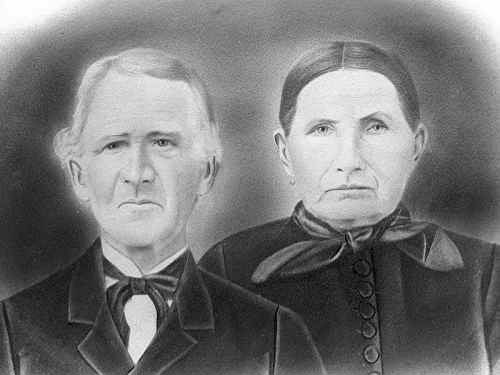
Johann Jodocus Rehagen (1818 – 1903) and Anna Angela Winkel (1826 – 1896)
In the next article I will transition over to the Rehagen’s influx into Miller County.
Article 7: John Rehagen’s Move to Miller County
In October of 1889 John and Anna Angela sold their farm in the Westphalia community for $3500 and then purchased a slightly smaller farm in the Charlestown (St. Elizabeth) community for $2500.
Possible motives for the move could be among the following:
-
$1000 cash profit from the sale and purchase.
-
Three of their younger children had previously moved to St. Elizabeth.
-
They would be living one mile from town and church rather than four miles.
-
Friction may have occurred in the Westphalia community or extended family.
It is very possible that all of the above came into play for their move. Whatever the reason, they now became part of a community that had only been established for about a decade. Just to keep the record straight - the community’s official name was Charlestown rather than St. Elizabeth. The original St. Elizabeth was about three miles north of the current St. Elizabeth and sat on a hill overlooking the Osage River. It was abandoned due to a sequence of illnesses and other tragic events. Officially, only the mailing address was St. Elizabeth until the 1960’s when Charlestown was renamed St. Elizabeth.
The new 200-acre farm was located in the very middle of what was known as 10-mile drive in my youth. At that time Louis Bax owned it. There was no driveway to the roads making up the 10-mile drive. Thus they had to use a path on the edge of a neighbor’s property and gained access to town on the north side near the home of Al Schell. This was certainly much more convenient than the situation in Westphalia. We don’t think about that much these days, but three additional miles in the days of horse and wagon travel would be a sizable consideration. In addition, the farm had water rights to a very nice spring located on the western border of the farm. Again we don’t think about that much these days since wells are so very common. In that time the spring would be a very valuable asset.
I will close this article with a summary of the marriages of John’s oldest children who remained rooted in Osage County.
Mary (1842 – 1937) and John Heinrich Schulte (1839 – 1901)
Francis Henry (1850 -1935) and Mary Caroline Schallen (1852 – 1893)
Mary Williams (1848 – 1908)
Conrad (1852 – 1919) and Gertrude Willibrand (1858 – 1898)
Anna Maria (1854 – 1887) and John Schruefer (1848 – 1876)
Conrad Stuckenschneider (1849 – 1879)
Charles Vermeulen (1859 – 1940)
One other child remained in Osage County. Theresa was born in November of 1860 and her last recorded appearance was on the 1870 Census. I would have to assume she died before reaching adulthood.
Article 8: Herman Stephen Rehagen (1858 - 1939)
John and Anna Angela Rehagen died in 1903 and 1896 respectively. They are both buried in St. Lawrence Cemetery. Interestingly their gravestones are written in German. Thus "Johann" was carved on his stone rather than John. I find this a little odd since he used John on all documents for decades prior to his death.
From this point I will focus on the children of John and Anna Angela who made their home in Miller County. As the title indicates this article will cover Herman Stephen Rehagen.
Herman married Gertrude Bock (1863 - 1928) on 15 February 1881 in Westphalia. Within a few years they moved to St. Elizabeth. Their property was about two miles south of St. Elizabeth behind the current quick shop on highway 52.
Six of their seven children lived to adulthood - three boys and three girls. Their son John was born 26 Nov 1887 and died 6 Oct 1888.
Every once in a while two families make a real connection. That's what happened with the girls of this family and three Kemna brothers. Angeline (1882 - 1949) married Henry Kemna (1878 - 1924), Mary (1884 - 1973) married Frank Kemna (1879 - 1960) and Wilhelmina (1897 - 1944) married Theodore Kemna (1883 - 1940). There have been other families where three siblings of each have married in that community, but rarely. I bet it made for some interesting family reunions.
The three boys didn't follow their sisters' example. They married into three separate families. William (1890 - 1958) married Catherine Struemph (1900 - 1930). Frank G. (1894 - 1970) married Mary Boeckman (1893 - 1961). George (1900 - 1989) married Mabel Leach (1912 - 1977).
The descendants of Herman and Gertrude have blessed St. Elizabeth and Miller County in larger numbers. I knew many of these descendants in my youth. They were classmates, schoolmates, friends and relatives. There were way too many to even count. If memory serves me correctly, Frank G. and Mary Rehagen worked at school in my early years.
You might note that I used Frank G. in the above paragraphs. You see Herman not only had a son named Frank he also had a brother named Frank. His brother was Frank W. or I could say Grandpa. More about him in a later article.
Pictured below is a portrait of Herman and Gertrude's family (Photo 05):
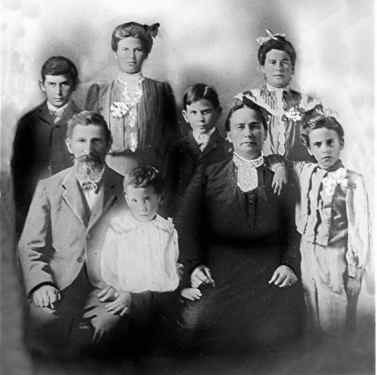
Family of Herman Stephen Rehagen (1858 – 1939)
On the front row (L to R) are Herman, George, Gertrude and Wilhelmina. Behind are Bill, Angela, Frank G. and Mary.
Article 9: Angela Rehagen (1856 – 1906)
Angela married George Dickneite (1849 – 1938) at Westphaila on 29 Apr 1873. After a few years of farming in Osage County George and Angela moved to St. Elizabeth.
They were well known in the community as owners of the Dickneite Store. The store was located just south of their stately white saltbox style home. In my youth the home was straight across the road from the current school and was owned by Urban Oligschlaeger. The foundation of that store remained until the house was taken down a couple of years ago.
Tragedy struck the Dickneite household in the summer of 1906. Angela and her ten-year-old daughter Rosa came down with typhoid fever. Angela died in late July and Rosa just a few weeks later. They are buried under a single stone in St. Lawrence Cemetery. It would be hard to imagine the grief the family went through from such a great loss.
In 1908 George sold his home and store to one of his competitors Ilde Schell. That was the end of the Dickneite store. George moved from the community along with his three youngest surviving children Gertrude (1888 – 1976), Regina (1892 – 1993) and Lawrence (1898 – 1976).
In addition to the four children mentioned above, George and Angela had five older daughters. Of these Mary (1875 – 1965) and Minnie (1885 – 1972) moved out of Miller County after they married. That leaves three daughters who remained in the county. Anna (1877 – 1949) married Joseph Bax (1870 - 1940). Katherine (1880 – 1977) married Frank Schulte (1869 – 1960). Elizabeth (1882 – 1961) married Ben Volmert (1868 – 1922).
Below is a nice portrait of the Dickneite family (Photo 06):
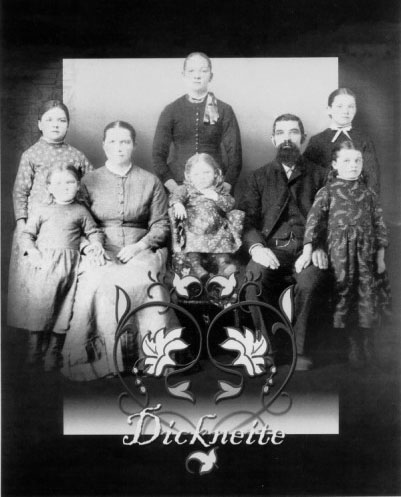
Family of George Dickneite (1849 – 1938)
The adults are of course Angela and George. On the left side is Katie with Minnie in front of her. In the center is Mary with Gertrude in front of her. On the right is Anna with Elizabeth in front of her. The other two girls Regina and Rosa and their only boy Lawrence were not yet born.
Wilhelmina Rehagen Heimann will be the next person of interest. I will take a little more time with her branch since there are now no living descendants.
Article #10 – Wilhelmina Rehagen (1863 – 1948)
Wilhelmina married Joseph Heimann (1855 – 1939) on 10 April 1883 in St. Elizabeth. She must have been living in St. Elizabeth for a while or else they would have more likely been married in Westphalia. Both Joseph and Wilhelmina were born and raised in the Westphalia area and the tradition would have been to marry in the bride’s parish church. She most likely hired out for help around the house with a relative – perhaps her brother Herman Stephen. At any rate the point is she considered St. Elizabeth to be her hometown and St. Lawrence her parish even though she was listed on the 1880 census as still being in the home of her parents in Westphalia. Their marriage would have been among the first ten taking place in the new church in that new community of St. Elizabeth or officially Charleston.
Below is their wedding picture. They made a rather handsome couple – well dressed and fair of face (Photo 07):
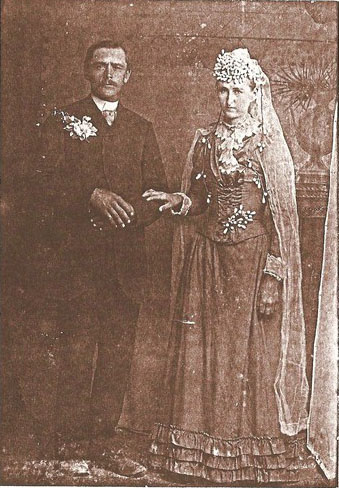
Joseph Heimann (1855 – 1939) and Wilhelmina Rehagen (1863 – 1948)
Now this couple was one of the very early pioneer families of the fledgling community. They settled in a little hollow west of town that later became known as “Heimann Holler.” The location in the short term was very beneficial to them as the road passing through the hollow was the road to the county seat of Tuscumbia. Those who lived along the Osage River between St. Elizabeth and Tuscumbia as well as anyone traveling to Tuscumbia for business had to pass by their property. Thus it was a prime spot for a general store. They not only had the store but along with it some 500 acres of land to farm. At some point they sold off a big part of the land and thus the store became the larger portion of their livelihood.
The couple had at least four children. The oldest was John (1884 – 1961) who remained a bachelor his entire life. Martin (1887 – 1966) married Carolina Tappehorn (1898 – 1986). Frank (1892 – 1961) married Clara Heisler (1897 – 1996). A fourth son Fred was born in 1900 and died the following year. Neither Martin or Frank’s marriage resulted in any children and so that branch of the family tree has died out.
I will pick up the Heimann story from here next time. For now I will finish with a second picture of Wilhelmina (left side) along with her oldest sibling Mary Rehagen Schulte who I mentioned earlier in articles 6 and 7. I do not know the location of the photo or when it was taken other than it had to be before Mary’s death in 1937 (Photo 08):
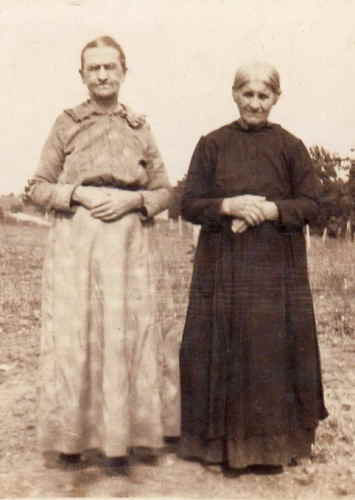
Wilhelmina Rehagen (1863 – 1948) and Mary Rehagen Schulte (1842 – 1937)
I will also finish up on Mary since I promised to tell more about her in previous articles. Her daughter Anna (1876 – 1967) married Stephen Doerhoff (1869 – 1921). Their child Vincent (1902 – 1979) was well known in the community as both the local barber and for his clock and watch repair. Vincent never married and lived with his mother on the east side of St. Elizabeth.
Article #11 – The Heimann Story
In the previous article I stated that the location of the Heimann Store served them well in the short term. When highway 52 was established that all drastically changed. At that point the traffic between St. Elizabeth and Tuscumbia no longer passed by their store and it must have killed their volume of business. I am not sure what all they sold, but at one time they even sold John Deere equipment. Their John Deere sign was sold on eBay just a few years ago as a matter of fact.
My only recollection of being in their store was when I was a young child of perhaps 8 or 9 years of age. It seemed as though somehow time had been frozen and that we were going back many years to a much less modern time. The store seemed so old and dark. I’m not sure what my parents bought that day but I remember my first stick of black licorice came from that store that day.
In addition to the farming and store, the Heimanns had a threshing business. Joseph along with his three sons took their Case threshing machine farm to farm to thresh grain from the bundles that were most likely formed by a binder. The following 1936 photo shows the threshing machine and the Heimanns in action (Photo 09):
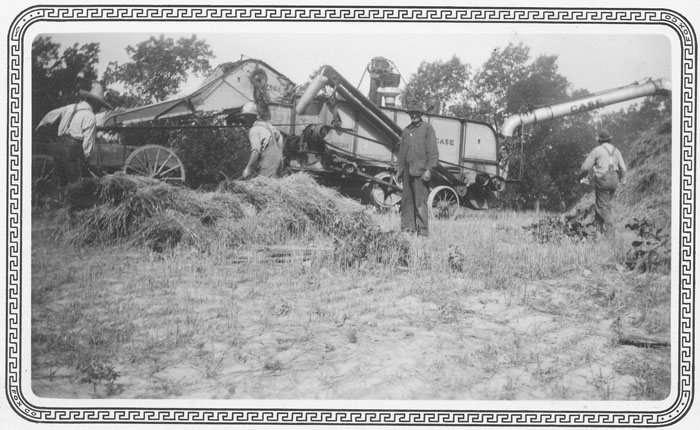
Heimanns and the Threshing Machine - 1936
From left to right they are John, Martin, Joseph and Frank. You can see the bundles being handled by John and Martin. You might also note that Frank appears to still have both hands. He lost his right hand at some point – perhaps the threshing machine had something to do with that.
A second photo shows the steel-wheeled tractor as well as the threshing machine. Note the jack located in front of the wheel. Those old tractors didn’t have strong brakes. The jack would assist in braking and was also used to adjust the tension on the belt driving the machine (Photo 10):
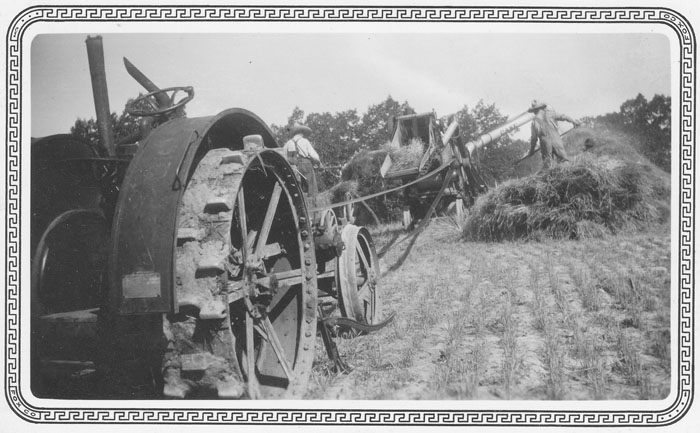
Steel-wheeled Tractor as well as the Threshing Machine - 1936
But the threshing business fell apart as well. With the invention of combines the binding and threshing processes became a thing of the past. Combines became common to St. Elizabeth in the early 1950’s. Thus the family’s financial state was once again severely impacted.
Article #12 – The last chapter for the Heimanns
The year 1961 would have to be the worst for the Heimann family. In April of that year Frank passed away. That was just the beginning however. On July 13th two convicts, Donald Ray Blood and Richard Beeman, escaped from Algoa Reformatory in Jefferson City. They stole boats along the Osage River to make their escape. On the following day they abandoned the river and took to land near St. Elizabeth. Their route took them right through Heimann Hollow. There they stole two guns, some cash and a car from the Heimann family. In the process John was struck in the back of the head with one of the guns and was gravely injured. The two convicts were captured later that day in the Barnett area.
John was taken to Humphrey’s Hospital in Tuscumbia and there he remained in critical condition and virtually paralyzed until his death a few weeks later on August 8th. I can’t help feeling so sorry for the remaining family. But after all of that it still wasn’t over yet. Beeman and Blood went on trial and Martin, his wife and Frank’s widow would have to relive the incident all over again. It was rather speedy however with a conviction in December. The convicted men were sentenced to life in prison.
I recall the event bringing a lot of activity to the town. I think it was the first time a helicopter was seen in the area. I have mentioned the Heimann family to a number of classmates and others in the community and everyone seems to have at least one vivid memory of John’s murder or some encounter with the family. Some named Beeman and Blood by name and said they would never forget those names. One remembers the helicopter used to search for the escapees. Another recalled the sale of the John Deere sign on eBay. Others spoke of the Heimann’s distrust of county government most likely due to the rerouting of traffic when Highway 52 was established. Still others speak of events they recall with the threshing machine.
Unfortunately in my lifetime I only had the opportunity to witness the tragedy and suffering of the last surviving members of the Heimann family. I am very happy to have researched the early years of the family. I feel like I have gotten to know what their early years in the area were all about. They were no doubt pioneers in the community and were successful by any measure. They contributed to the welfare of the community through their store and threshing business. Although Wilhelmina’s branch of the Rehagen tree has died out, it’s good to know the full scope of their lives. Both success and tragedy weaved their way through the fibers of the events of their lives.
I am going to close this article with one last photo of the Heimanns. It was taken before November of 1939 when Joseph passed away. Left to right they are Joseph, Frank, Clara, John, Martin and Carolina. You can see that Frank is now missing his right hand. The only family member not in the picture is Wilhelmina, but she was pictured previously with her oldest sister (Photo 11):
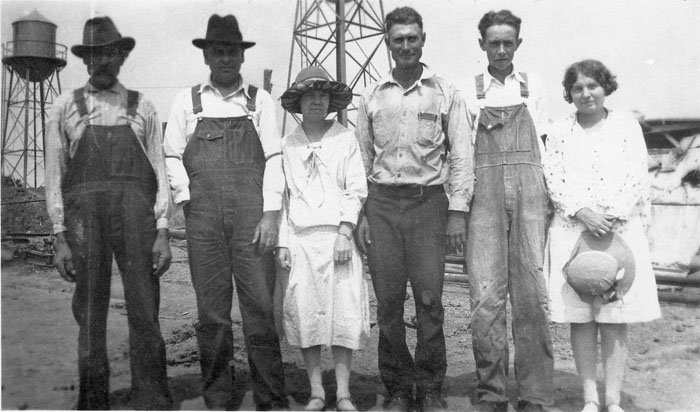
The Heimanns
Article #13 – Frank William Rehagen (1867 – 1919)
Frank was born in Westphalia and moved to St. Elizabeth with his parents in 1890. He married Anna Mary Dickneite 25 Oct 1892 in St. Elizabeth. She and her parents, Stephen (1846-1898) and Anna Maria Linnebrink Dickneite (1848-1914), also moved from Westphalia to St. Elizabeth.
The young couple lived with his parents and blessed them with grandchildren. Frank's mother died 13 Feb 1896, but got to know the first two grandchildren, Anna (1893) and John (1895).
The following picture shows the young couple with their first child Anna taken in about 1895. The portrait of his parents, shown in an earlier article, is believed to have been taken the same day (Photo 12):
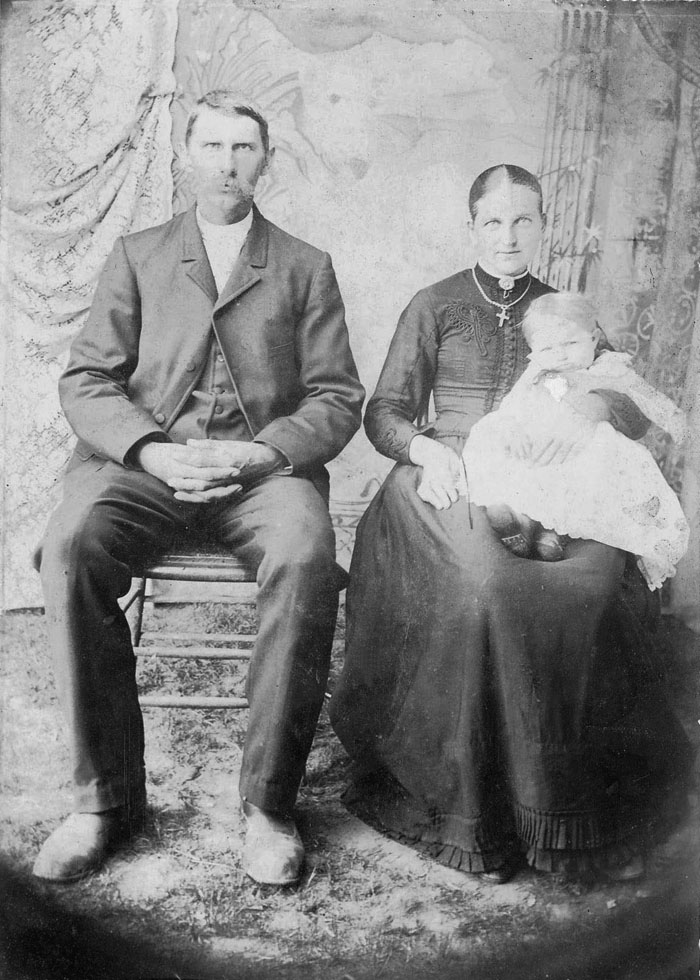
Frank William Rehagen (1867 – 1919) and Anna Mary Dickneite with daughter Anna - circa 1895
Just three days after the death of his wife, John sold his farm to his son Frank. John remained in the household of his son for the remainder of his years. He was blessed with four more grandchildren - Martha (1896), Stephan (1898), Joseph (1900) and Rose (1902).
I believe John had a very special relationship with his son Frank. Throughout their lifetimes John taught Frank to play several musical instruments. Not only did he sell his farm at a loss to Frank, he also favored him in his will and made him the executor of his estate. They shared life in so many ways from the time of Frank's birth till John's passing in 1903 - some 36 years in all.
Frank and Annie had four more children after 1903 - Adolph (1904), Bernard (1906), Emma (1908) and George (1910). This makes ten children in all. Unfortunately Bernard died in 1907. The remaining nine lived to adulthood.
I keep coming back to the musical thing. It was the collective musical skills of this family that impressed me so. They owned at least one of each of the following: zither, base fiddle, violin, cello, harmonica and piano. Most of the family members played at least one of those. My mother, Emma, played the piano which we believe was given to her by her sister Rose. She also learned to play the church organ as well. It must have been quite the scene when they gathered up all those instruments and played. My oldest cousin summed it up very well. He said "I just wanted to be a member of that household." That's how much he enjoyed being there. To be fair I should also mention that the fun-loving nature of mom's brothers most likely contributed to his statement.
Article #14 – Frank William Rehagen continued
Frank died of tuberculosis on 8 May 1919. His wife Anna survived until 4 Nov 1927. Both are buried in St. Lawrence cemetery in St. Elizabeth. Their son Steven fell victim to tuberculosis as well and passed away 21 Jan 1934. He is buried in St. Anthony.
The following picture is the only one containing Steven that I have been able to come up with. Steven is on the right and my father Joseph Weidinger (1901-1960) is on the left. I believe Steven lived with my parents after the Rehagen home burned in about 1930. This photo was taken at my grandfather Jacob Weidinger's farm about one mile north of St. Elizabeth. It almost adjoined the Rehagen farm on the eastern edge (Photo 13):
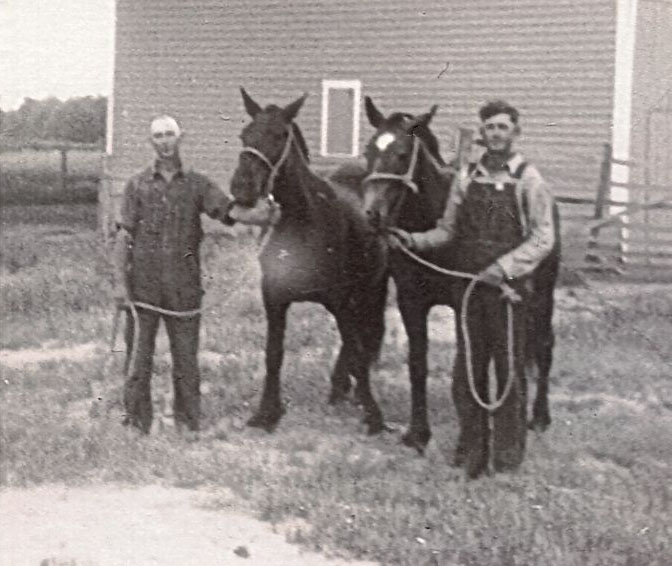
Joseph Weidinger (1901-1960) and Stephan Rehagen (1898-1934)
The remaining eight children married and lived to be very respectable ages. Below is a little more about them and their spouses.
Anna (1893-1978) married Joseph Otto (1885-1952) - buried in Dixon.
John (1895-1963) married Mathilda Lindenbusch (1904-1972) - buried in St. Anthony.
Martha (1896-1976) married Mike Otto (1892-1956) - buried in St. Anthony.
Joseph (1900-1982) married Martha Herx (1907-1995) - buried in St. Anthony.
Rose (1902-1965) married Carl Short (1907-1966) - buried in St. Elizabeth.
Adolph (1904-1966) married Theresia Schaffer (1913-1996) - buried in Meta.
Emma (1908-1979) married Joseph Weidinger (1901-1960) - buried in St. Elizabeth.
George (1910-1971) married Catherine Scheulen (1920-1994) - buried in St. Elizabeth.
The following photo shows all eight of the Rehagen siblings. It is believed to have been taken in St. Anthony, however, the event is not known. They are (L to R) Anna, Martha, Rose and Emma on the front row and John, Joseph, Adolph and George on the back row. George is standing on the ground rather than on the step like his brothers thus looks to be much shorter. He was in fact the tallest of the boys (Photo 14):
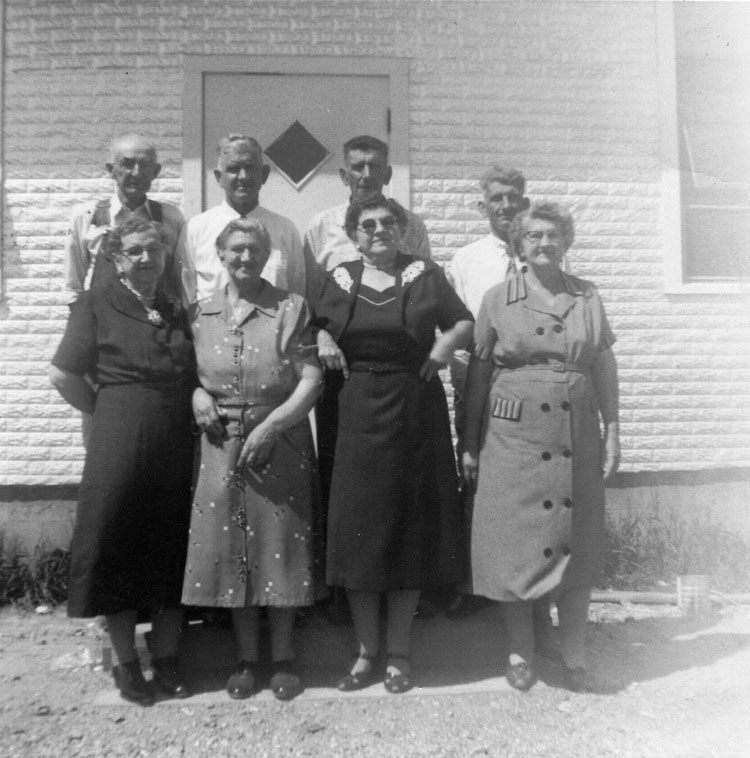
The Rehagen Siblings
This concludes the articles about the early years of the Rehagen family. A more complete Rehagen history in written form (over 140 pages) can be seen at the museum in Tuscumbia. For your convenience I am providing a PDF version of this document (TheRehagenClan.PDF) suitable for printing or to be downloaded.
RUSH-LOVEALL FAMILY
Henson Rush was born about 1795 near Harrodsburg, Virginia. He was married to Margaret Stouton Oct. 14, 1825 in Mercer County, Kentucky. Margaret was born 1802 in Virginia to James Stout and Abigail Holloway. Henson and Margaret moved to Adair County. They had six children, James M. in 1826, Ephraim H. on Feb. 28, 1828; John William on Apr. 6, 1831; Joshua in 1832; Amanda Jane in 1835; and George A. in 1838.
James was married in 1848 to Mary Blake. They set out for a place of their own, but near Booneville, MO., Mary died during labor. Having lost both wife and child, he went to California in the Gold Rush of 1849.
Ehpraim Henson Rush married Sarah Loveall on Apr. 10, 1849, in Adair County, Kentucky. Sarah was born Apr. 16, 1832 to Jonathon Loveall and Amy Ruth Allen. Sometime in 1849 John W. married Eliza Louisa Kemp.
In 1850, Amanda Jane married Stephen Loveall, a brother to Sarah. Stephen was born in 1829.Henson Rush died in Adair County, Kentucky, about 1850.
Jonathon Loveall, Jr. was born 1781 in Virginia to Jonathon Loveall, Sr. and Vianna Stevens. Jonathon married Elizabeth Canaday in Wayne County, Kentucky, on Dec. 8, 1808. They had 5 Children: Nancy born 1809 married Daniel Allen, the son of Stephen Allen and Sarah Radford; Viney born 1811 married W. William Allen, brother to Daniel Allen; Hiram Henry born 1815 married Mary Canaday; Absolem born 1824 married Dicy Mills; and William born 1824 married Nancy Jane Sortor. Elizabeth (Canaday) Loveall died about 1825. Jonathon remarried Amy Ruth Allen, on Jan. 15, 1827 in Edmondson County, Ky, Amy Ruth was a sister to Jonathon's son-in-laws Daniel and William. Jonathon and Ruth had 7 children: Malinda born 1828; Stephen who married Amanda Rush was born 1829; Sarah who married Ephraim H. Rush was born Apr. 16, 1832; Theresa Jane born 1834; Margaret born 1839; Elizabeth born 1842; and Daniel David born Sep. 15, 1845.
For one reason or another they all decided to move west. They loaded what they could on wagons and sold what they had to. They all left Adair County, Kentucky in 1850 and came to Miller County, Missouri. Jonathon and Ruth Loveall and their children; Ephraim and Sarah Rush; John and Louisa Rush; Stephen and Amanda Loveall; Margaret Rush and her remaining children. The extended family, a total of 16 people, settled along Jim Henry Creek, in Miller County. To this day there are still family members living on the land they settled, and those that have moved away return when they can to visit. Soon after they settled, they built a church where they could worship and their children were baptized and married. And as their lives came to end, and they were called to their heavenly home, their remains were laid to rest in the cemetery next to the church.
On May 27, 1852 Malinda, eldest daughter of Jonathon and Ruth Loveall, married Stephen Walker in Miller County, Mo.
Meanwhile, James M. Rush, the eldest son of Henson and Margaret Rush, not having found any gold in California, returned by ship, sailing around the southern tip of South America. He caught up with his family in Miller County. On Feb. 1, 1855 he married Theresa Jane Loveall, sister to Sarah and Stephen.
On Dec. 30, 1866 Margaret Loveall married Louis H. Winters, his second marriage. His first wife was Sarah Ralston.
On Apr. 30, 1865 Daniel David Loveall married Francis Anne Sweaney, daughter of Levi Woodson Sweany and Myra Blackard.
Ephraim H. and Sally Rush family:
John Riley born Jun. 17, 1854
Sarah Elizabeth born 1857
Mary Eliza born Mar. 12, 1860
Oliver Stout born Mar. 3, 1862
Lydia Marie born 1865
Zerelda Ann born Mar. 15, 1868
Ephraim David born Aug. 7, 1869
James M. and Theresa Jane Family:
Henry Jasper born Jan. 3, 1856
Harriet E. born Sep. 1858
Benjamin Franklin born Mar. 3, 1860
James Annie born Feb. 12, 1864
Nancy Jane born Mar. 27, 1867
Caleb N. born 1868
William Thornton born Jun. 13, 1874
Stephen and Amanda Loveall family:
Mary Margaret born 1855
George Taylor born Apr. 10, 1859
Lucy E. born Jun. 13, 1861
John W. and Louisa Rush family:
Martha Jane born Jun. 9, 1952
Joice A. born 1857
Mary Amanda born Nov. 1858
Robert Jefferson born Jan. 1863
John William, Jr. born Dec. 22, 1864
Nancy Ella born Apr. 27, 1867
John W. Rush married 2nd Margaret Buster, daughter of John Tate Buster and Mary Bryant on Mar. 23, 1874. Their children:
Rosa L. born Jun. 17, 1875
Artimika born Aug. 5, 1877
Henson Tate born Jan. 8, 1879
Albert T. born Oct. 12, 1883
Stephen and Malinda (Loveall) Walker family:
William Riley born
John Franklin born Oct. 15, 1856
Louis H. and Sarah (Ralston) Winters family:
Amelia Regina born Sep. 14, 1851
Samuel Barton born Apr. 3, 1856
Catherine 'Kate' born Jun. 16, 1862
Mary Delray born Feb. 21, 1863
John Henry born 1864
Louis H. and Margaret (Loveall) Winters family:
Alrick David born Oct. 18, 1866
Louis Steve born Apr. 6, 1871
William W. born 1872
Frederick Wesley born 1874
Ruth Ianthy born 1879
Daniel David and Francis (Sweaney) Loveall family:
Viola Catherine born Mar. 15, 1866
James Madison born Jan. 8, 1868
Schuyler Califax born Mar. 20, 1870
Charlotte Tennessee born Nov. 11, 1871
Sarah Jane born Jan. 31, 1874
Jessie Lee born May 8, 1890
On June 11, 1863, James M. and John W. Rush enlisted. They served together in Co. 'B', 6th
Missouri State Volunteer Cavalry and were discharged on Jul. 18, 1865.
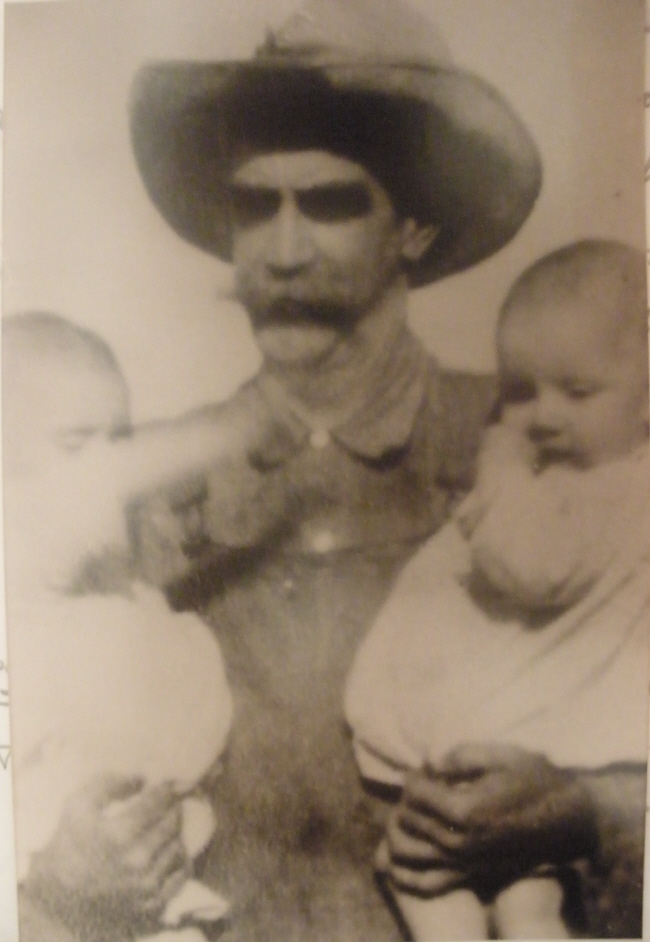 Rush; Earl, Bill & grandfather-Oliver Stout Rush
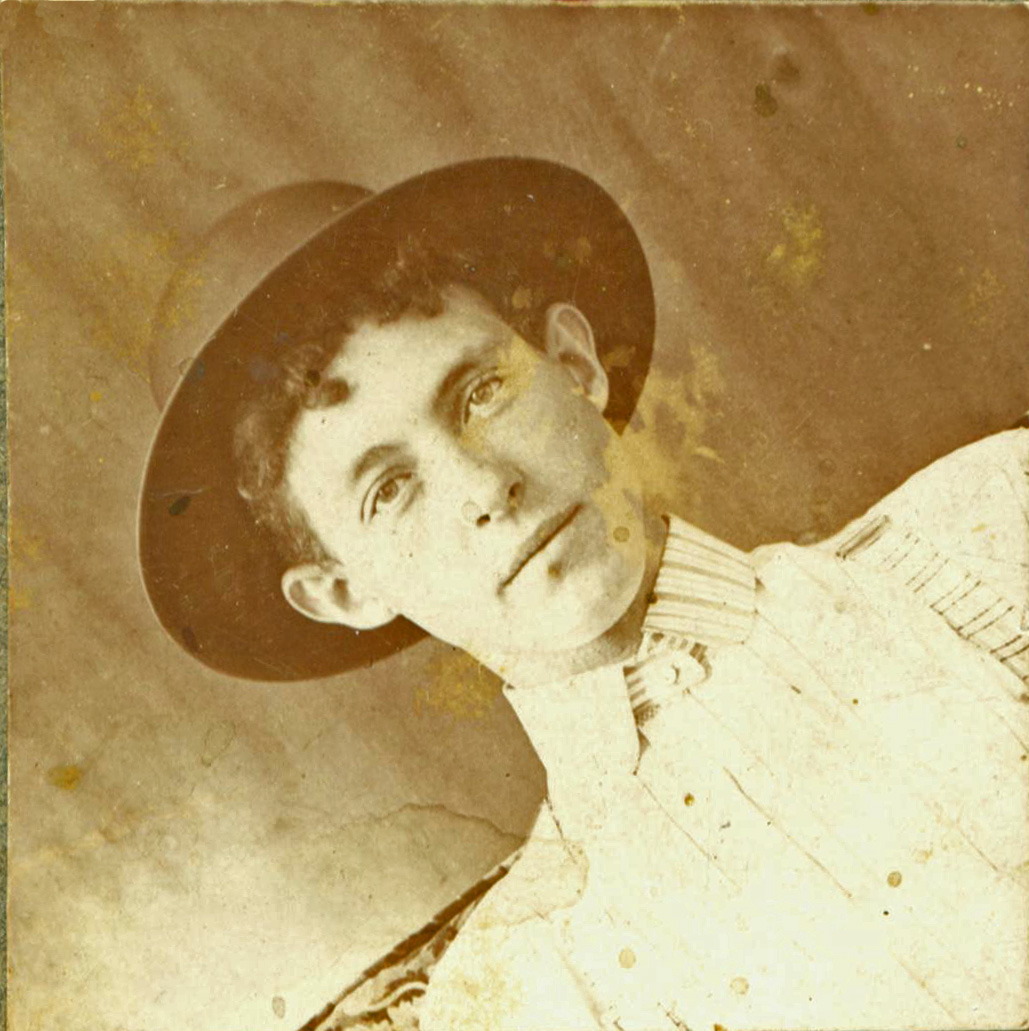 Albert Rush
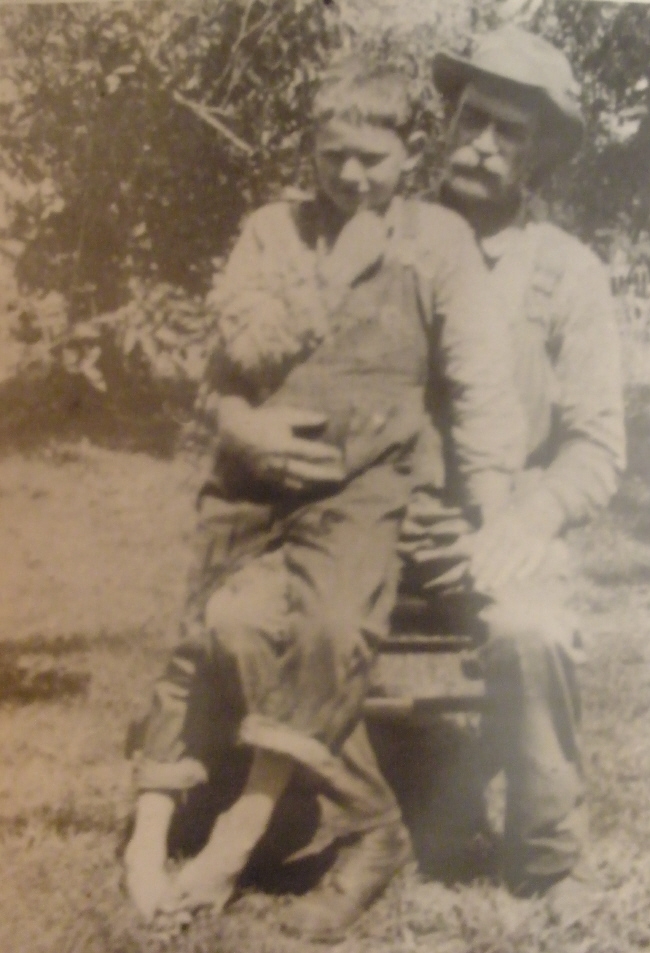 Rush; Oliver Stout w/Grandson
|

